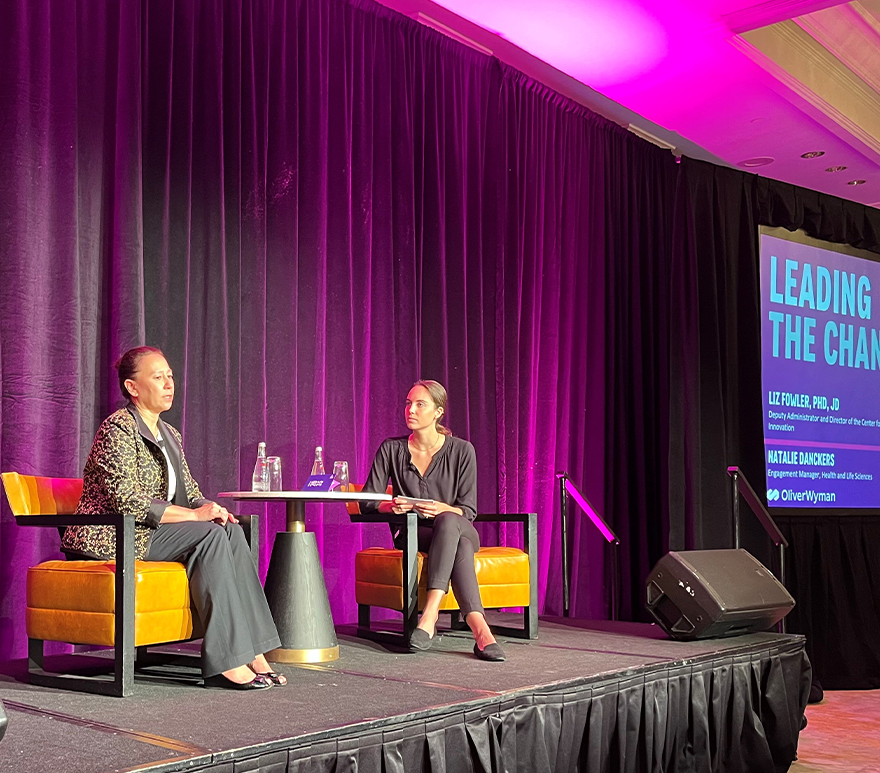When asked to detail what’s working — and isn’t — at the Center for Medicare and Medicaid Innovation, Liz Fowler speaks with deep authority. After all, she played a critical role in drafting the Affordable Care Act, the law that established the CMS Innovation Center, during her time as Chief Counsel to the Senate Finance Committee. And in 2021, President Joe Biden tapped Fowler to lead the agency she helped create.
During the fall of 2023, Fowler spoke to a gathering of Oliver Wyman’s Health and Life Sciences practice to share her perspective on where the Innovation Center may be headed. While she’s proud of the agency’s accomplishments during its first decade, Fowler said the Innovation Center needs to continue pushing the envelope if it is going to create lasting change.
“When we’ve looked at the impact of the Innovation Center’s work, we’ve looked at a specific model — Did that model work and by work, we were mostly looking at if it saved money. What we want to do is broaden the horizon in terms of how we look at success,” Fowler said during a Q&A session led by Oliver Wyman’s Natalie Danckers.
Evaluation of Innovation Center programs should go deeper and assess whether care delivery changed, Fowler said.
“Did we change the patient experience? Is it sustainable? Is it something that, once the model goes away, can remain in place? And then, did it affect other parts of the system or other providers?” she said.
Fowler spotlighted three areas where the Innovation Center aims to broaden its strategy and impact on the industry.
Bending the cost curve
The Congressional Budget Office in 2010 projected that the Innovation Center would generate significant savings during its first 10 years — reduce federal spending by $2.8 billion and lower spending on benefits by $10.3 billion. Those savings never materialized. Just the opposite, in fact. CBO in October 2023 reported that the Innovation Center increased spending by $5.4 billion, that’s on top of the $7.9 billion it took to run its programs.
Fowler acknowledged that the Innovation Center hasn’t yielded the savings that CBO projected in 2010 but said that every model has yielded important lessons and valuable experience. The results, she said, also reflect limitations in how models were designed. Most models are voluntary with a short five-year time frame. Providers often have the flexibility to drop out if they aren’t performing well. That makes it difficult to generate long-term savings.
“It doesn't mean that we're not trying. We still have our eye on the ball,” she said. “If you improve quality and the care experience, we think you can eventually save money, but probably not in a five-year model. We’re looking at longer models; we're looking at mandatory models. Congress has delayed previous efforts when we've tried to do that a couple of times so we need to be cautious and keep that in mind.”
Over the summer, the Innovation Center sought input on a proposed mandatory episode-based payment model. The intent is to cover more Medicare beneficiaries by accountable care arrangements. That, Fowler said, would help improve care coordination.
“We need to find a way to move everything up stream so we catch people before they're sick and that (means) getting more providers and more specialists involved,” she added. “We’re trying to figure out how to create an incentive that's not just about money, but about delivering care in a better way and being more integrated and being able to do more for your patients.”
Addressing health equity
The Biden administration made addressing health equity a central part of its policy agenda. Health equity measures were added to Medicare Advantage star ratings, for instance. The Innovation Center is incorporating health equity into new payment models as well. The ACO Realizing Equity, Access, and Community Health model, which launched in 2023, includes a health equity benchmark that aims to incentivize ACOs to cover more underserved communities and beneficiaries.
The Innovation Center is also looking for ways to bring more safety net and rural providers into the mix, including federally qualified health centers and community health centers. And it is improving efforts to help providers reach underserved populations.
“We have a new primary care model and we now have the ability to tell who's applying to come into the model and plot them against a map. When we see that they're not going into underserved areas, we can target our outreach,” Fowler said.
Creating flexible models
A key learning during the Innovation Center’s first 10 years is that providers are at different stages of being willing and able to jump into a new care and payment models. That reality was reinforced during the COVID-19 pandemic. Health systems that were more invested in value-based care and accountable care were better positioned to succeed. They had a track record of doing home visits, coordinating care, using nurse practitioners and other providers. As the Innovation Center considers the next generation of payment and care models, it needs to account for the fact that providers are at varying stages of being able to take on risk.
“There’s a hesitancy to want to jump into a new payment model,” Fowler said. “One of the things that we have to do at the Innovation Center is think about an on ramp for people who've never been part of value-based care. We didn't see a lot of safety net providers in our programs. What can we do to bring them on board? It probably means less risk and more upfront investment — help with data and resources that they might not have.”
Then there are providers at the other end of the spectrum; those that are immersed in value-based care and ready to take on even more risk. The Innovation Center must make sure there’s a pathway that allows those providers to keep evolving, Fowler said, adding, “It’s about being mindful of where providers are in their journey and making sure there's opportunities for them.”


